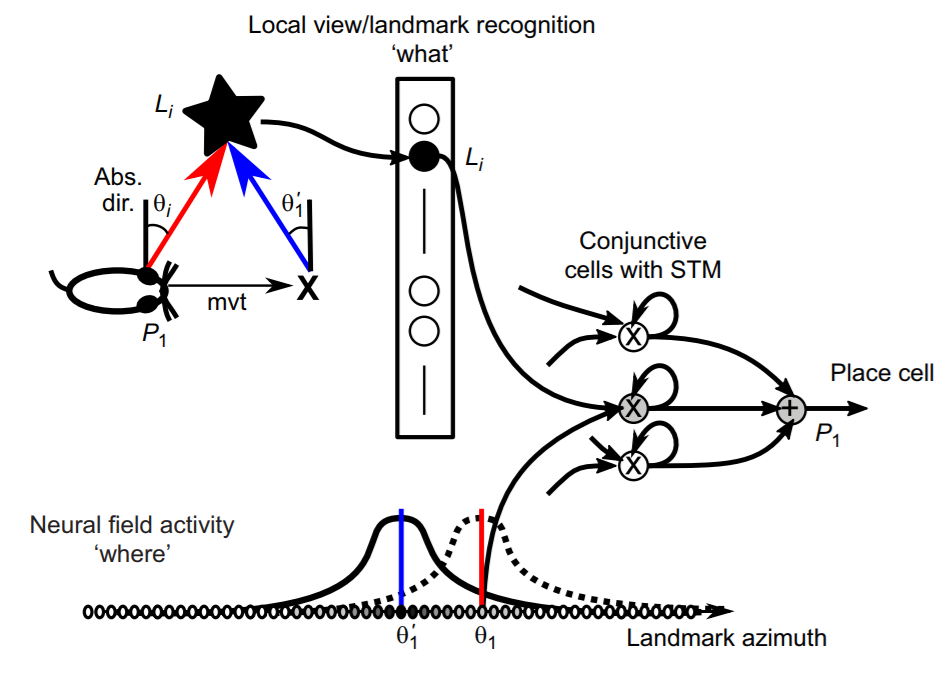
How a simple robotics model of mammal navigation is useful to interpret neurobiological recordings
Place recognition is a complex process involving idiothetic and allothetic information. In mammals, evidence suggests that visual information stemming from the temporal and parietal cortical areas (‘what’ and ‘where’ information) is merged at the level of the entorhinal cortex (EC) to build a compact code of a place.Local views extracted from specific feature points can provide information important for view cells (in primates) and place cells (in rodents) even when the environment changes dramatically. Robotics experiments using conjunctive cells merging ‘what’ and ‘where’ information related to different local views show their important role for obtaining place cells with strong generalization capabilities.
Fig. Visual place cell from the merging of ‘what’ and ‘where’ information. (The figure is from the Gaussier et al. 2019.)
In the paper Gaussier et al. 2019, the authors show how a simple robotics model of mammal navigation is useful to interpret neurobiological recordings. They question the current models of the dMEC as a path integrator. Instead, they propose that the EC is a generic merging tool that builds a compact representation of the cortical activity. They summarize experiments and simulations showing that grid cells related to PI could be explained as a modulo projection of cortical activity computed in the RSC, where PI could take place. Furthermore, they suggest that the visual grid cells recorded in the human EC could also be explained by the same mechanism.
For further info, please read the paper Gaussier et al. 2019.
Philippe Gaussier, Jean Paul Banquet, Nicolas Cuperlier, Mathias Quoy, Lise Aubin, Pierre-Yves Jacob, Francesca Sargolini, Etienne Save, Jeffrey L. Krichmar, Bruno Poucet. Merging information in the entorhinal cortex: what can we learn from robotics experiments and modeling? Journal of Experimental Biology 2019 222: jeb186932 doi: 10.1242/jeb.186932 Published 6 February 2019
About
CogNav Blog
New discovery worth spreading on cognitive navigation in neurorobotics and neuroscience
Recent Posts
- How to build a bio-inspired hardware implementation of an analog spike-based hippocampus memory model?
- How does the brain select what to remember during sleep?
- How hippocampal activity encodes numerous memories of specific events in life?
- How egocentric coding properties arise from its presynaptic inputs, and how egocentric cells represent items across different behavioral contexts?
- How the medial entorhinal cortex develops during learning and influences memory?
Tags
Categories
- 3D Movement
- 3D Navigation
- 3D Path Integration
- 3D Perception
- 3D SLAM
- 3D Spatial Representation
- AI Navigation
- Bio-Inspired Robotics
- Brain-Inspired Navigation
- Cognitive Map
- Cognitive Navigation
- Episodic Memory
- Excerpt Notes
- Flying Vehicle Navigation
- Goal Representation
- Insect Navigation
- Learning to Navigate
- Neural Basis of Navigation
- Path Integration
- Path Planning
- Project
- Research Tips
- Robotic Vision
- Self-Flying Vehicles
- Spatial Cognition
- Spatial Cognitive Computing
- Spatial Coordinate System
- Spatial Memory
- Time
- Unclassified
- Visual Cortex
- Visual Cue Cells
Links
- Laboratory of Nachum Ulanovsky
- Jeffery Lab
- BatLab
- The NeuroBat Lab
- Taube Lab
- Laurens Group
- Romani Lab
- Moser Group
- O’Keefe Group
- DoellerLab
- MilfordRobotics Group
- The Space and Memory group
- Angelaki Lab
- Spatial Cognition Lab
- McNaughton Lab
- Conradt Group
- The Fiete Lab
- The Cacucci Lab
- The Burak Lab
- Knierim Lab
- Clark Spatial Navigation & Memory Lab
- Computational Memory Lab
- The Dombeck Lab
- Zugaro Lab
- Insect Robotics Group
- The Nagel Lab
- Basu Lab
- Spatial Perception and Memory lab
- The Neuroecology lab
- The Nagel Lab
- Neural Modeling and Interface Lab
- Memory and Navigation Circuits Group
- Neural Circuits and Memory Lab
- The lab of Arseny Finkelstein
- The Epstein Lab
- Gu Lab (Spatial Navigation and Memory)
- Fisher Lab (Neural Circuits for Navigation)
- The Alexander Lab (Spatial Cognition and Memory)
- Harvey Lab (Neural Circuits for Navigation)
- Buzsáki Lab
- ……

